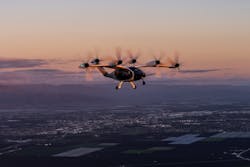UAM: The Infrastructure Challenge

Urban Air Mobility (UAM) is envisioned as a safe and efficient aviation transportation system using highly automated aircraft to transport passengers or cargo at lower altitudes within urban and suburban areas. Organizations in industry and government are investing significant resources to cultivate an ecosystem that supports these operations – including manufacturers of electric vertical takeoff and landing aircraft (eVTOL), builders of takeoff and landing areas, and researchers who are studying how to conduct UAM operations safely and efficiently alongside other airspace users.
While many believe UAM is a relatively new concept, research indicates that commercial UAM operations originated in the United States in the 1940s. For example, from 1947 to 1971, Los Angeles Airways used helicopters to transport people and mail between dozens of locations in the Los Angeles basin, including Disneyland and Los Angeles International Airport. During this same era, from 1949 to 1979, New York Airways used helicopters to fly passengers in the New York area between heliports in Manhattan and airports such as LaGuardia, JFK and Newark. Tragically, due to accidents caused by mechanical failures that resulted in fatalities, both companies ceased operations.
What could UAM operations look like in the future? UAM will use quiet and efficient manned and unmanned vehicles to conduct on-demand and scheduled operations. These could include emergency medical evacuations, rescue operations, humanitarian missions, news gathering, ground traffic flow assessment, weather monitoring, package delivery, cargo and passenger transport.
In 2018, the National Aeronautics and Space Administration (NASA) presented a study that evaluated potential takeoff and landing areas in the San Francisco Bay Area and concluded that the door-to-door time savings resulting from UAM could be significant for trips greater than 15 miles. However, it noted that several technical challenges must be overcome to achieve UAM operations at a higher tempo and higher density than can be accommodated by the current air traffic control (ATC) system.
Over the past few years, NASA has been working in collaboration with partners and stakeholders to develop detailed concepts of operations for UAM airspace integration at different stages of operational maturity, including:
• Emergent UAM operations: Characterized by low-tempo, low-density flights along a small set of fixed routes between a few takeoff and landing areas
• Early expanded UAM operations: Characterized by higher-tempo, higher-density flights in a small network of vertiports feeding a common hub location and managed by UAM operator and third-party services
• Mature UAM operations: Characterized by high-tempo, high-density flights in a network with multiple hub locations, potentially involving more vehicles and operations in an area than are currently supported in the NAS
It is expected that initial UAM operations will be for demonstration purposes and will be required to comply with current airspace rules and regulations, similar to current VFR operations. Most likely, these UAM flights will be conducted by human pilots onboard the aircraft and with current ATC procedures.
However, a number of organizations are pursuing UAM concepts that extend the range of possibilities.
For example, some UAM aircraft manufacturers are developing vehicles that would not require a human pilot onboard. Instead, these aircraft would instead be piloted remotely by some combination of humans on the ground, autonomous systems on the ground, and/or autonomous systems in the air.
Ultimately, UAM will not only require navigable airspace to support increased air traffic in urban environments, but the airport infrastructure to support public access to electrically powered aircraft – including a reliable source of electrical power and vertiports that serve as multi-modal hubs for passengers to easily transition from one transportation mode to another.
In September 2022, the FAA released vertiport design standards to support the safe integration of advanced air mobility aircraft that will transport passengers or cargo at lower altitudes in rural, urban and suburban areas. The design standards are intended to provide key information for airport sponsors, owners and operators to begin development of facilities that will support eVTOL operations.
Importantly, before commencing ground infrastructure development, a comprehensive study of the particular region must be completed that considers all stages of operations – ranging from departure and approach patterns to passenger boarding, vehicle charging and required aircraft maintenance. In addition, back-up landing sites must be available to accommodate any problems or emergencies an aircraft might experience in flight.
While UAM promises to offer a more diverse segment of the population access to lower-cost, efficient air transportation, it may also raise opposition from airport neighbors who are concerned about any potential negative impacts. Airports must be prepared to address public concerns about safety, noise and emissions.
For example, scheduled commercial charter operations (known as “charter-by-the-seat” flights) have caused some community and government stakeholders to question whether selling single seats on charter aircraft – particularly those with published and planned flight departure times – should be prohibited. As costs decrease and the UAM market favors selling single seats on smaller aircraft flying at lower altitudes, similar questions will surely be raised.
Innovative solutions are needed to ensure UAM operations are not only safe and efficient, but environmentally responsible and financially viable. While the development of eVTOL prototypes and federal regulations are moving forward, the issue of who will pay for UAM infrastructure at our nation’s general aviation airports remains unaddressed.
Can these costs be passed along to the consumer? It seems neither feasible nor reasonable for airports to place this responsibility on its tenant businesses and fixed-base operators. Funding and building a safe, efficient and sustainable UAM ecosystem will require partnerships and collaborative efforts among airport sponsors, aircraft manufacturers, infrastructure developers, and local and federal governments. The future of UAM depends on it.
Curt Castagna, president and CEO of Aeroplex Group Partners, is also president and CEO of the National Air Transportation Association, the immediate past chair of the Los Angeles County Airport Commission, and president of the Van Nuys and Long Beach airport associations. A certified private and instrument-rated pilot, he continues to instruct courses in aviation administration at Cypress Community College and Cal State Los Angeles.
About the Author

Curt Castagna
President and CEO
Curt Castagna, President/CEO of Ascension Group Partners, serves as president and CEO of the National Air Transportation Association, member and past chair of the Los Angeles County Airport Commission, and president of the Van Nuys and Long Beach airport associations. A certified private, seaplane and instrument-rated pilot, he continues to instruct courses in aviation administration at Cypress Community College and Cal State Los Angeles.